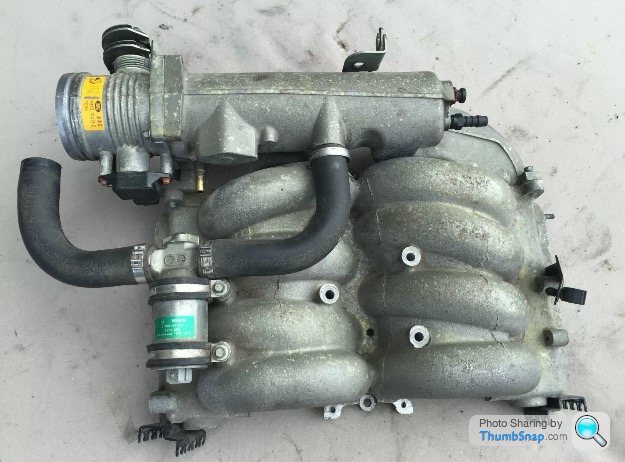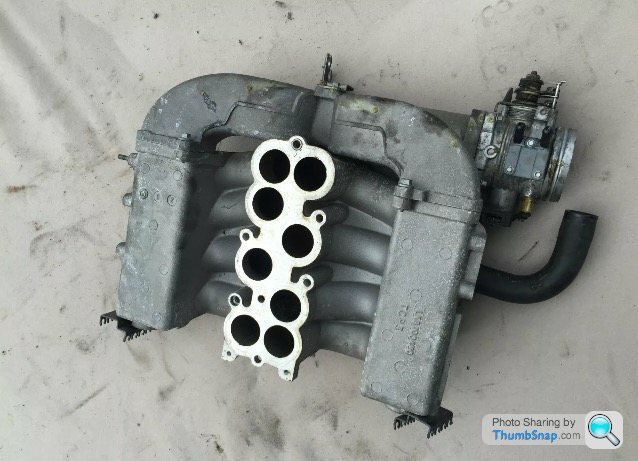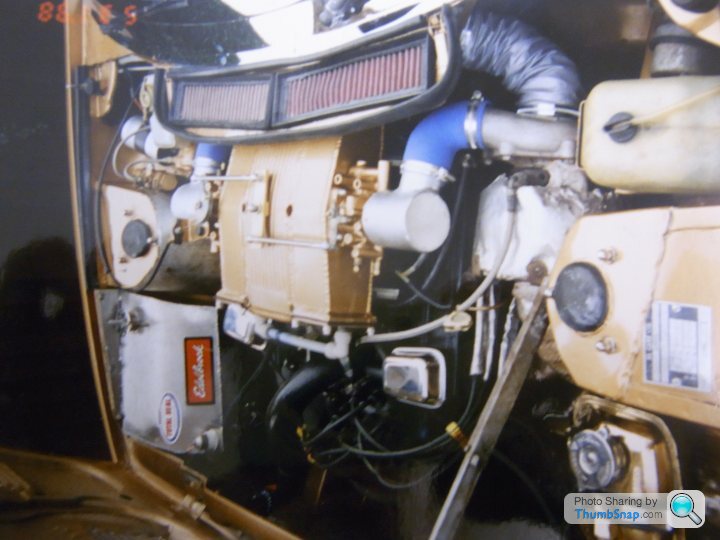Independent runner inlet manifold
Discussion
That's not an individual runner manifold; it has only one throttle body.
That manifold has got long rubbers, so it might be more suitable for low rpm mud boggers.
I don't think it will be an upgrade on a TVR.
Here are some rover v8 IR manifolds.
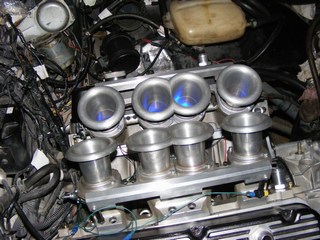

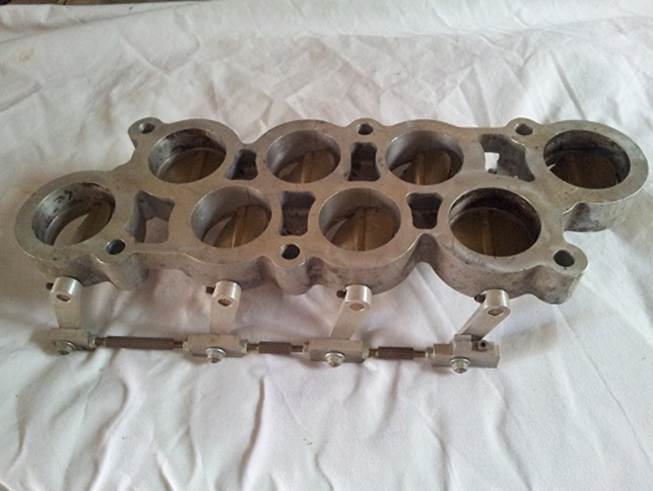
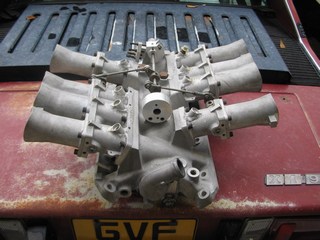
See here for more:
http://www.mez.co.uk/ms12-new.html
That manifold has got long rubbers, so it might be more suitable for low rpm mud boggers.
I don't think it will be an upgrade on a TVR.
Here are some rover v8 IR manifolds.



See here for more:
http://www.mez.co.uk/ms12-new.html
Just chatting, Rover v8's aren't a high revving engine so wouldn't a longer runner with perhaps a dual plane inlet suit with perhaps increased torque on the lower and midrange revs rather than give it at higher rpm with a relative low redline. As standard a TVR runs out of revs in top gear before tuning for extra power at high rpm, so increased mid range power would really increase acceleration as a road car at least?
Fitting two throttle bodies to the Thor manifold looks very doable.
However it won't make a dual plane out of it; none of the runners cross over to the other side.
Also the runner diameter might be smaller than on the TVRs.
What LS engine are you talking about, I can't find an OEM one with twin throttle bodies.
However it won't make a dual plane out of it; none of the runners cross over to the other side.
Also the runner diameter might be smaller than on the TVRs.
What LS engine are you talking about, I can't find an OEM one with twin throttle bodies.
That's my my manifold archive linked above.
The p38 thor manifold with it's long thin runners is designed for ...a heavy 4x4 - which means low end torque and no need for high flow at high rpm.
The exact opposite of what you want on a tvr. Read the notes that i got from john edwards who explained the limits of the manifold.
The p38 thor manifold with it's long thin runners is designed for ...a heavy 4x4 - which means low end torque and no need for high flow at high rpm.
The exact opposite of what you want on a tvr. Read the notes that i got from john edwards who explained the limits of the manifold.
eliot said:
That's my my manifold archive linked above.
The p38 thor manifold with it's long thin runners is designed for ...a heavy 4x4 - which means low end torque and no need for high flow at high rpm.
The exact opposite of what you want on a tvr. Read the notes that i got from john edwards who explained the limits of the manifold.
Very interesting read The p38 thor manifold with it's long thin runners is designed for ...a heavy 4x4 - which means low end torque and no need for high flow at high rpm.
The exact opposite of what you want on a tvr. Read the notes that i got from john edwards who explained the limits of the manifold.
 . The picture below is what was in my head from the start so obviously someone has already got there.
. The picture below is what was in my head from the start so obviously someone has already got there. I used that oem Thor manifold as the example of improved midrange torque, as a road car midrange torque improves acceleration. Race cars use high rpm but road cars don't. A TVR still weights a tad over a metric ton and that isn't light compared to real race cars in the 700-800kg mark or even less. Improved low end torque is key and maintaining it rather than increase a rev limiter to get the max bhp figure, of course tuning is an art and I appreciate that but those inlet manifolds below seem to do the improved low end torque whilst maintaining high end flow.
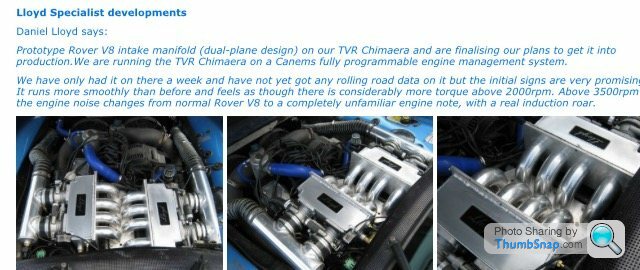
eliot said:
That's my my manifold archive linked above.
The p38 thor manifold with it's long thin runners is designed for ...a heavy 4x4 - which means low end torque and no need for high flow at high rpm.
The exact opposite of what you want on a tvr. Read the notes that i got from john edwards who explained the limits of the manifold.
A few points in response, but merely to extend discussing the Thor manifold beyond a rather curt and potentially over simplified dismissal of the idea. All I'm looking to do is re-stimulate thought on the Thor discussion beyond the above negative position taken by Eliot. As such I'll play the role of Devil's advocate, this approach is not intended as an attack on anyone so please don't take it as such The p38 thor manifold with it's long thin runners is designed for ...a heavy 4x4 - which means low end torque and no need for high flow at high rpm.
The exact opposite of what you want on a tvr. Read the notes that i got from john edwards who explained the limits of the manifold.

Argument against: The P38 Thor manifold with it's long thin runners is designed for a heavy 4x4
Devil's advocate response: The 14CUX plenum and inlet manifold wasn't designed as a performance set up for TVRs either, it too was directly lifted from the earlier generation Range Rover/Discovery IE the very same heavy 4x4
Argument against: The P38 Thor manifold with it's long thin runner design delivers low end torque and is not designed with high flow at high rpm in mind
Devil's advocate response: So what, people seem to conveniently forget the real reason RV8 TVRs are quick is not because they have a single plane manifold... it's because the TVR is so light, if you fit a Thor manifold to a Chimaera or Griffith it will still be around 7-800kg lighter than the P38 Range Rover you took the inlet manifold from.
Don't underestimate this massive weight difference, drive a 4.0 litre Chimaera back to back with a 4.0 litre Range Rover and you'll soon see what I mean and I use the 4.0 litre Chimaera as our example here because as we all know TVR did very little to tune the 4.0 litre cars. The 4.0 litres Chimaera RV8 engines were pretty much just lifted from the Range Rover production line, the only reason a 4.0 litre Chimaera gets down the road like it does is the car only weighs 1060kg.
Argument against: The P38 Thor manifold restricts air flow at high rpm making it unsuitable for a sports car application
Devil's advocate response: While it's true the earlier 14CUX single plane inlet manifold has the potential to offer better flow at high RPM, to properly understand how much of an advantage this is you need to look at where in the rev range most RV8 TVR engines make peak torque & horsepower.
If you study a dyno graph from say a standard 4.0 litre Chimaera you'll see it typically makes peak torque at 4,000rpm and peak horsepower at 5,000rpm, making revving the 4.0 litre Chimaera beyond 5,000rpm completely pointless. As we can see the RV8 in a 4.0 litre Chimaera is hardly a high revving performance engine, as already pointed out it's really just a 4.0 litre Range Rover lump that behaves exactly as such.
So the real question to all this is... "If I fit a Thor inlet manifold to my RV8 TVR what will the positive and negative effects be and feel like in the real world ?"
The real answer can only be proved and demonstrated on a dyno, as far as I'm aware no one has actually ever fitted a Thor inlet manifold to a RV8 TVR, so both the doubter and the Delvi's advocate can only speculate on the real world results so I do think it's important that both sides of the argument are given equal consideration.
The one inarguable fact in favour of the Thor inlet manifold idea is that it will definitely deliver drivability benefits from idle to 2,000rmp where the 14CUX type manifold by design will always deliver drivability challenges due to the inevitable and well understood charge robbing pulse effects a single plane manifold introduces on a V8 engine.
I think it's fairly safe to say if someone did fit a Thor inlet manifold to a RV8 TVR the car would definitely drive lot nicer from idle to 2,000rpm, the real problem with this low speed drivability improvement is it's not a particularly exciting topic for macho chaps to discuss on a forum. But the uncomfortable truth we should accept is we all actually spend a lot more more time driving around 1500 - 2300rpm than we'd like to admit, and its my experience any improvement in drivability you can implement in this area on a RV8 TVR makes the car hugely more enjoyable to drive.
Low speed drivability isn't a sexy topic of discussion so it's importance (especially in TVR circles) is massively overlooked and an extremely neglected topic on these pages, people do discuss shunting but as far as I'm aware no one has suggested what would clearly be by far the best solution, namely replacing the single plane inlet manifold with the readily available Thor manifold.
So is fitting a Thor manifold to a RV8 TVR a good ided? For me the answer is not simply to dismiss the concept by saying the Thor inlet has long runners are designed for a heavy 4x4, the real way to properly answer the question is for someone to fit one and try it.
It really boils down to personal choice, and your answers if you ask yourself these questions....
Q1: How much value do I give to improving the often ignored drivability element of my TVRs engine behaviour?
Q2: Given the real reason a TVR is fast is because its light, and given an RV8 in a TVR still isn't what you'd call a high revving engine... will the Thor manifold really limit top end performance that much in the real world when driving the car on the road?
Q3: If there is indeed a small loss in top end performance how much of it am I prepared to sacrifice in exchange for a TVR that drives much much nicer in the rev band we all actually spend most of our time driving in on the road?
If you feel like me the benefits may well outweigh the negatives only moving to trying the idea will finally prove or disprove if it was a good idea or not.
Finally I'll end by saying it's not uncommon for guys in the Range Rover community to swap their 14CUX inlet manifold and plenum for the Thor design, they do this because they know their Rangie will drive much much nicer. Do these guys rev their engines to 5,000rpm? well the ones I know do, and do so quite regularly without any issues whatsoever.
Of course the conversion isn't quite as simple as just slapping a Thor set up on your TVR, there are quite a few bits and bobs you'll need (thermostat housing ect ect), but fortunately Thor inlet manifolds complete with fuel rail & injectors remain cheap & readily available and conveniently this guy will supply you a kit with everything you need to make the conversion work....
http://www.megasquirt-v8.co.uk/ms_thor.php
I've come so close to pulling the trigger on this project myself it's not funny, but the biggest elephant in the room for me has always been... will my Chimaera bonnet shut after fitting the Thor inlet manifold?
This sounds like a minor issue but it's potentially the biggest hurdle to the project, the Thor manifold places the throttle body in a position forward of the engine's lateral centre, where the 14CUX throttle body sits further back in a central position, as both the Chimaera and Griffith bonnets slope away quite dramatically from this point forward I do unfortunately anticipate bonnet to throttle body interference issues if I fit the Thor set up.
This bonnet closure consideration is (far more than any high rpm air flow concerns) the only reason I haven't tried fitting a Thor inlet manifold to my Canems equipped dual fuel 4.0 litre Chimaera. People said I shouldn't convert my TVR to gas because it would spoil it, I knew the real reason TVRs fly is because even with a fairly standard RV8 they only really perform like they do because they are such a light car, so I knew it would still fly on gas (which it most certainly does).
It's much the same for me with the Thor inlet manifold idea, I'm very confident the benefits it would give will far outweigh any small loss it may or in reality may not inflict on top end performance, especially keeping in mind 'Top End' for the vast majority of RV8 equiped TVRs is actually only 5,000rpm

In summary there's a lot more food for thought here than simply dismissing the idea of fitting a Thor inlet manifold to a RV8 TVR by saying....
eliot said:
The p38 thor manifold with it's long thin runners is designed for ...a heavy 4x4 - which means low end torque and no need for high flow at high rpm.
The exact opposite of what you want on a tvr. Read the notes that i got from john edwards who explained the limits of the manifold.
I'm not having a go here so please don't get upset, all I'm doing is presenting the counter argument which is surely the bedrock of any intelligent discussion The exact opposite of what you want on a tvr. Read the notes that i got from john edwards who explained the limits of the manifold.

Edited by ChimpOnGas on Thursday 2nd February 11:35
Very interesting Dave. I know its horses for courses but for me im most definately in the low down torque, as much as i can get please, and zero shunting brigade. I've soon learned that willy waving high bhp numbers is of no use whatsoever in normal day to day driving.
So much so ive just swapped my 214 cam for the slightly milder 218. Yes the 214 will pull 1krpm in 4th 5th ok but what i cant make it do is drive nicely in 2nd 3rd gear at 1500rpm with a constant very light throttle. No amount of messing with fueling or ignition timing would totally cure it. Hopefully the 218 will sort it.
So for me this Thor manifold is interesting stuff. Looking at that pic i wonder if it could be turned round so the throttle body goes to the back on the opposite side.
So much so ive just swapped my 214 cam for the slightly milder 218. Yes the 214 will pull 1krpm in 4th 5th ok but what i cant make it do is drive nicely in 2nd 3rd gear at 1500rpm with a constant very light throttle. No amount of messing with fueling or ignition timing would totally cure it. Hopefully the 218 will sort it.
So for me this Thor manifold is interesting stuff. Looking at that pic i wonder if it could be turned round so the throttle body goes to the back on the opposite side.
Next time you go for a drive in your TVR you should mentally record how long you actually spend between idle and 2,000rpm, then stay aware of how much time you spend cruising between 2,500 and 3,000rpm, finally keep a mental record of how long you genuinely venture over 5,000rpm.
I bet you'll be surprised at the results
It's my belief you will feel fek all difference between the single plane 14CUX manifold and the Thor set up when cruising between 2,500 and 3,000rpm and very little or no impact on the top end too. However, if you run a Thor inlet manifold where you will notice a big difference is in the improvement between idle and 2,000rpm.
So with no negatives under cruise conditions and barely any noticeable loss of top end in your 5,000rpm peak power TVR you are just left with the benefits in the idle to 2,000rpm range, an area we actually all spend more time in than we'd like to admit.
So as Eliot seems to suggest, will the Thor manifold really mess up the top end on a TVR engine that typically tops out at a rather lowly 5,000rpm? Personally I doubt it, but my theory will need properly testing to prove who's right. Lets not forget a TVR only gets down the road as well as it does because its a very light car, it has little or nothing to do with it's single plane inlet manifold that after all was just robbed from an earlier Range Rover anyway.
The engineers who designed the Thor inlet manifold were clever people, they knew to keep the ancient Rover V8 engine a viable proposition in a world where cars were offering better and better drivability they needed to do something radical with it. Cleverly they achieved their goals by developing an infinitely superior engine management system to the 14CUX, and by fitting the engine with the far superior Thor inlet manifold design.
These two significant developments combined to give what was already considered a prehistoric engine a few more years of life, as we know they didn't last long before BMW took over and implemented a far more modern power plant. But lets be clear these engine management system updates and the Thor inlet manifold design were the biggest steps forward for this engine during it's entire 40 years of development.
Take a close look at a Thor inlet manifold and think about the development and production budget that must have gone into it, now consider if it had never been developed by Land Rover but if it was presented to you today as a modification.
Take moment to closely inspect the Thor manifold keeping all these things in mind and you'll soon see its quite a complex and sophisticated thing; it certainly must have cost a pretty penny to design, tool up for and cast. So what would you pay for this production engineered OEM quality component, more than an ACT twin plenum perhaps?
Well the good news is you can actually buy a good as new complete Thor set up for as little as £200, if you think about it that's absolutely amazing value for what you get, an OEM quality component that could ultimately deliver the biggest improvement to the way your RV8 TVR drives by a country mile.
In fact... assuming you can still shut your bonnet after fitting it, for just £200 it could well be the best value TVR modification ever... and by a country mile!
Food for thought boys... food for thought indeed
I bet you'll be surprised at the results

It's my belief you will feel fek all difference between the single plane 14CUX manifold and the Thor set up when cruising between 2,500 and 3,000rpm and very little or no impact on the top end too. However, if you run a Thor inlet manifold where you will notice a big difference is in the improvement between idle and 2,000rpm.
So with no negatives under cruise conditions and barely any noticeable loss of top end in your 5,000rpm peak power TVR you are just left with the benefits in the idle to 2,000rpm range, an area we actually all spend more time in than we'd like to admit.
So as Eliot seems to suggest, will the Thor manifold really mess up the top end on a TVR engine that typically tops out at a rather lowly 5,000rpm? Personally I doubt it, but my theory will need properly testing to prove who's right. Lets not forget a TVR only gets down the road as well as it does because its a very light car, it has little or nothing to do with it's single plane inlet manifold that after all was just robbed from an earlier Range Rover anyway.
The engineers who designed the Thor inlet manifold were clever people, they knew to keep the ancient Rover V8 engine a viable proposition in a world where cars were offering better and better drivability they needed to do something radical with it. Cleverly they achieved their goals by developing an infinitely superior engine management system to the 14CUX, and by fitting the engine with the far superior Thor inlet manifold design.
These two significant developments combined to give what was already considered a prehistoric engine a few more years of life, as we know they didn't last long before BMW took over and implemented a far more modern power plant. But lets be clear these engine management system updates and the Thor inlet manifold design were the biggest steps forward for this engine during it's entire 40 years of development.
Take a close look at a Thor inlet manifold and think about the development and production budget that must have gone into it, now consider if it had never been developed by Land Rover but if it was presented to you today as a modification.
Take moment to closely inspect the Thor manifold keeping all these things in mind and you'll soon see its quite a complex and sophisticated thing; it certainly must have cost a pretty penny to design, tool up for and cast. So what would you pay for this production engineered OEM quality component, more than an ACT twin plenum perhaps?
Well the good news is you can actually buy a good as new complete Thor set up for as little as £200, if you think about it that's absolutely amazing value for what you get, an OEM quality component that could ultimately deliver the biggest improvement to the way your RV8 TVR drives by a country mile.
In fact... assuming you can still shut your bonnet after fitting it, for just £200 it could well be the best value TVR modification ever... and by a country mile!
Food for thought boys... food for thought indeed

Edited by ChimpOnGas on Thursday 2nd February 20:17
ChimpOnGas said:
Boosted LS1 said:
The Thor manifold also lends itself to twin throttles with integral chargecoolers ;-)
Read this, didn't really think about it... then thought about it properly again....Oh my God that's a good idea

Fabulous words. I started this discussion but your words have detailed it. That Thor inlet gave the 4.6 increased torque and bhp over the previous version and I remember from my Vauxhall days seeing a standard Astra gte 16v out drag a current then Astra Btcc race car at santa pod.
More low down torque makes a faster road car of which a Thor manifold achieves at at very reasonable price
of which a Thor manifold achieves at at very reasonable price 
More low down torque makes a faster road car
 of which a Thor manifold achieves at at very reasonable price
of which a Thor manifold achieves at at very reasonable price 
RobXjcoupe said:
Fabulous words. I started this discussion but your words have detailed it. That Thor inlet gave the 4.6 increased torque and bhp over the previous version and I remember from my Vauxhall days seeing a standard Astra gte 16v out drag a current then Astra Btcc race car at santa pod.
More low down torque makes a faster road car of which a Thor manifold achieves at at very reasonable price
of which a Thor manifold achieves at at very reasonable price 
I doubt you'll see anything at the top end, indeed as Eliot says you may well find the Thor manifold will chip a few BHP off the top end, the question is it it worth trading a lot more low down torque for a relatively small loss of power in the upper rev range?More low down torque makes a faster road car
 of which a Thor manifold achieves at at very reasonable price
of which a Thor manifold achieves at at very reasonable price 
The answer to that question is probably more one of personal choice than something we can apply a black & white response to because everyone has slightly different expectations of the way their RV8 TVR performs, as you may have already guessed I'm very much in the smooth driving camp

I expect what you'll find after fitting a Thor set up is the shape of the torque curve will look very different to when the car was on the standard single plane manifold, but it's not entirely clear how that will translate to engine feel and throttle response, it may prove a great mod or it could just end up not suiting the sports car application and nobody really knows until they try it.
Even then you have to accept we are all potentially looking for different types of behaviour from or old Rover V8, some may be looking to create a peaky rev hungry racer, others like me will put a lot more importance on making their RV8 TVR smooth and refined in a rev band where these cars often deliver rather compromised drivability.
In summary I think we need to get away from the performance obsession and focus on how the Thor manifold will change the feel and character of the engine's power delivery, my best guess is the Thor manifold will deliver benefits well beyond any small loss performance it may or may not inflict on the top end.
I'd love to try one on my Canems equipped dual fuel 4.0 litre Chimaera, but I do worry I'd spend a lot of time and effort only to discover I can't shut my bonnet
 . We really need to do some measuring up, has anyone got a Thor inlet manifold set up they can put next to the 14CUX arrangement? It looks to me the area of concern will be the throttle body itself, and whether it will or won't interfere with the steeply sloping Chim & Griff bonnet lines?
. We really need to do some measuring up, has anyone got a Thor inlet manifold set up they can put next to the 14CUX arrangement? It looks to me the area of concern will be the throttle body itself, and whether it will or won't interfere with the steeply sloping Chim & Griff bonnet lines?If we can prove it fits I will be happy to try the idea on 'Ol Gasbag', if it turns out I don't like what it does to my engine behaviour the whole thing is after all.... completely reversible. TBH I've always felt fitting the Thor manifold to my TVR would be an interesting experiment so if the bonnet clearance question can be reliably answered I will pull the trigger and report back here on the result

My late friend who had a Griff 500 bought a thor plenum with the idea of doing the dual throttle bodies idea about 10 years ago (those photos on my site are of the actual unit we bought) After taking a look at it, we decided against it and went with carbon trumpets and 72mm plenum. I cant recall if he ever placed it on the engine to check the clearance, i think (knowing what he was like) he had checked that it would clear a griff bonnet.
There's no doubt it will increase the driveability due to the characteristics of the manifold BUT only if you keep the single OEM throttle body - I think going with dual throttles bodies will result in making it worse though, the "tip-in" i.e just of idle response will be worse as you have two throttles opening up and resulting in a drop in air velocity and probably back to shunting issues again.
Will it restrict top end performance ? Given that most Griff 500's struggle to make much over 280 bhp, I dont think it's going to impact on the smaller largely bone stock 4.0 engine which was fitted with this manifold anyway.
Jonathan Douglas of JE Engineering commented on this manifold:
The throttle body has a 68 mm throttle as standard and again, we often take this out, in this case to 71.5 mm. The Thor manifold, when used with either a standard cam or a mildly tuned cam, gives a strong torque peak at around 2,000 rpm, much higher than that achievable with the Lucas plenum design, but even with careful gas-flow work the power is limited. We find it difficult to achieve more than around 280 bhp with this manifold, where a similar amount of effort on a Lucas Plenum manifold will yield 320 bhp (but with less torque below 3,500 rpm
So if he can get 280bhp out of the manifold with a 71.5 throttle body, making it a dual throttlebody is not going to add much and probably take away driveability - unless you are talking about fitting a pair of ~45mm bodies i guess.
Couple of other points:
1) The idle air bypass is different for the hotwire, you either need to drive the OEM thor idle valve with an aftermarket ECU or plumb the OEM hotwire idle valve inline somehow.
2) The fuel rail is 'dead-headed' - which means there's no regulator on the fuel rail. So you either need to weld a fitting on the end and fit a regulator or I believe it's possible to fit the hotwire fuel rail with a bit of bending and forcing.
3) there's no vacuum nipple - so if you are still using a crappy vacuum advance distributor you will need to fit one (or better bin it and go trigger wheel)
edit;
I've owned range rovers with the hotwire and the later thor manifold and the difference is noticeable in terms of low end torque and driveability in a P38. In a TVR it will probably feel like you have dropped a big block chevy in.
There's no doubt it will increase the driveability due to the characteristics of the manifold BUT only if you keep the single OEM throttle body - I think going with dual throttles bodies will result in making it worse though, the "tip-in" i.e just of idle response will be worse as you have two throttles opening up and resulting in a drop in air velocity and probably back to shunting issues again.
Will it restrict top end performance ? Given that most Griff 500's struggle to make much over 280 bhp, I dont think it's going to impact on the smaller largely bone stock 4.0 engine which was fitted with this manifold anyway.
Jonathan Douglas of JE Engineering commented on this manifold:
The throttle body has a 68 mm throttle as standard and again, we often take this out, in this case to 71.5 mm. The Thor manifold, when used with either a standard cam or a mildly tuned cam, gives a strong torque peak at around 2,000 rpm, much higher than that achievable with the Lucas plenum design, but even with careful gas-flow work the power is limited. We find it difficult to achieve more than around 280 bhp with this manifold, where a similar amount of effort on a Lucas Plenum manifold will yield 320 bhp (but with less torque below 3,500 rpm
So if he can get 280bhp out of the manifold with a 71.5 throttle body, making it a dual throttlebody is not going to add much and probably take away driveability - unless you are talking about fitting a pair of ~45mm bodies i guess.
Couple of other points:
1) The idle air bypass is different for the hotwire, you either need to drive the OEM thor idle valve with an aftermarket ECU or plumb the OEM hotwire idle valve inline somehow.
2) The fuel rail is 'dead-headed' - which means there's no regulator on the fuel rail. So you either need to weld a fitting on the end and fit a regulator or I believe it's possible to fit the hotwire fuel rail with a bit of bending and forcing.
3) there's no vacuum nipple - so if you are still using a crappy vacuum advance distributor you will need to fit one (or better bin it and go trigger wheel)
edit;
I've owned range rovers with the hotwire and the later thor manifold and the difference is noticeable in terms of low end torque and driveability in a P38. In a TVR it will probably feel like you have dropped a big block chevy in.
Edited by eliot on Friday 3rd February 12:44
TaimarTurbo said:
Fitting two throttle bodies to the Thor manifold looks very doable.
However it won't make a dual plane out of it; none of the runners cross over to the other side.
However it won't make a dual plane out of it; none of the runners cross over to the other side.
RobXjcoupe said:
Very interesting read  . The picture below is what was in my head from the start so obviously someone has already got there.
. The picture below is what was in my head from the start so obviously someone has already got there. 
Neither the Thor nor the Lloyds manifold are proper dual plane - as mentioned in the first quote, neither have runners crossing over to the other side, meaning cross contamination will be present in both plenums in each model.. . The picture below is what was in my head from the start so obviously someone has already got there.
. The picture below is what was in my head from the start so obviously someone has already got there. 
Gassing Station | Griffith | Top of Page | What's New | My Stuff




